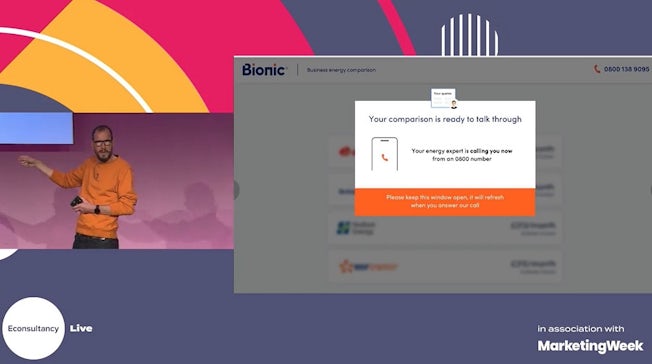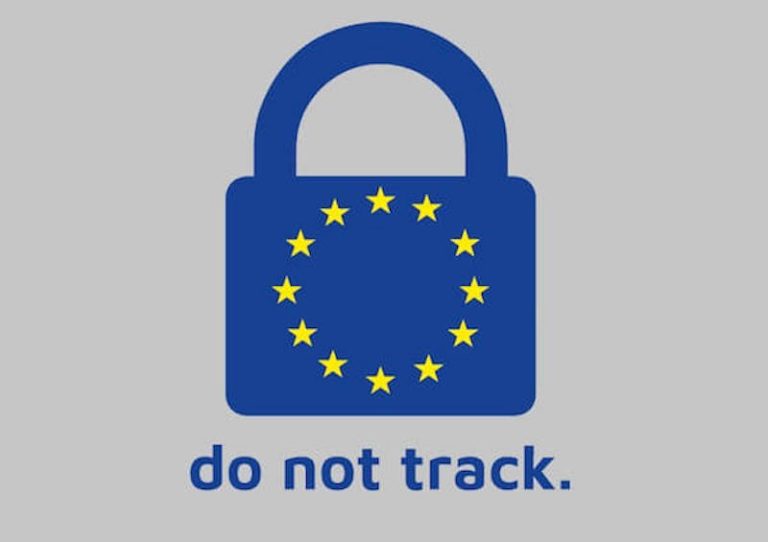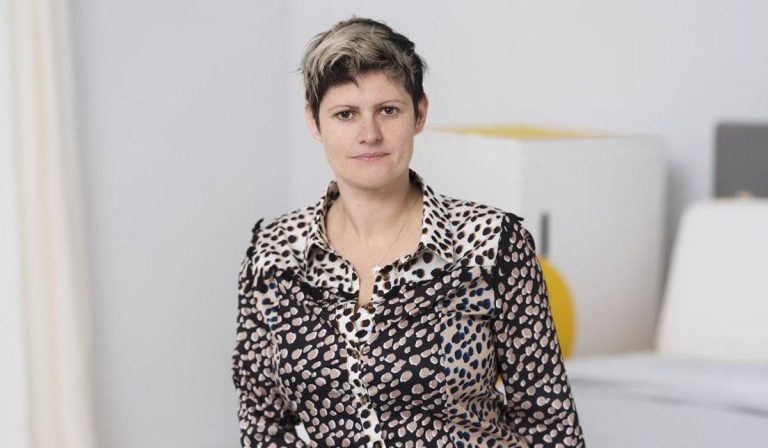Additionally, he said, “these pages have been through hundreds of design iterations so that we know that in a split second it gives our target audience exactly what they need to go further.”
Despite many business owners believing that the solution to this is a pure digital end-to-end solution, Britton stated that this doesn’t actually meet their true needs.
During his talk at Econsultancy Live, Britton elaborated on this transformation, and the idea that for a high stakes, low interest product, CX is not about transferring a customer from the web to the phone, but “bringing in expert support, dynamically, when it’s needed and only for as long as is needed before passing back to digital.”
Britton believes this is the case because – despite CX leaders being three times more likely to outperform their sector than mainstream competitors, according to Econsultancy research – “there are some really fundamental customer needs that digital hasn’t done a very good job of addressing yet.”
The first and second ages of CX
“Ignore conventional wisdom, ignore me blathering on about second stage, ignore all that stuff online about ecommerce and SAAS – it’s just conventional stuff,” he said. “Go back to first principles with your target customers and even then, don’t ask them what they think they want because they’ll tell you something erroneous. Instead, observe their true needs and build around that.”
Finally, he added, “we know that they hate not knowing what happens next. So a core part of our proposition is we don’t just leave you to it. We then manage the supplier on your behalf and make sure the new contract you agree to actually goes live in 10 months’ time or whatever it is. That’s a whole other dimension to our customer experience that we have to think about.”
“So, I’m really interested in… is there something else? That third age of customer experience, designed from the ground up to perfectly blend smart tech and human service?”
“How do we know which products or suppliers to trust without an expert to help?” Britton asked, also pointing out the fact that intermediaries such as TripAdvisor and Trustpilot face their own problems.
“Our customers love the idea of our young, energetic, experts working on their behalf,” said Britton. “Like having an extra employee…”
The internet then disrupted this, with the second age of customer experience moving on to “digital DIY and full product access” which as Britton explained, essentially meant giving customers unfettered access to inventory and letting them self-serve.
Live chat is often just a sticking plaster
“It converts at less than 1%,” he said. “It leaves them with huge unanswered questions, and that’s just the minority. About 20 to 25% of small business owners start their journey for these products online. What the majority are doing is still going to the same broker they found thirty years ago in the Yellow Pages out of habit, they haven’t thought ‘is there a better way?’ So, a pure digital solution does nothing at all for the majority of the market.”
In practical terms, he continued, “we talk about business energy comparison with human experts. We’ll compare 20+ trusted UK business energy suppliers, and then talk you through the quotes on your screen. That’s a real agent, so straight away you understand what kind of experience you’re going to be getting here.”
To further establish what this third age of CX might look like, exactly, Bionic went back to basics. “We spent a lot of time observing the life of small business owners, how they currently deal with energy, insurance, broadband and finance,” Britton explained.
“It’s a whole industry, to try to filter out spam reviews and bought and paid positive reviews… And it also relies on normal people who sometimes don’t quite understand what’s going on.” Take reviews for the TripAdvisor app on the App Store, for instance, a lot of which are actually by people who mistakenly think this is the place to post their hotel reviews. “People have really fundamentally misunderstood what’s going on there,” said Britton.
The third age of CX
Britton says that the answer is indeed hybrid. “Something that combines the efficiency and choice of digital with the reassurance and customisation of world class human service,” he explained. Britton also clarified that he is not referring to a digital on-ramp to a basically offline experience, here, like a user requesting a demo or quote online, and a human advisor calling them later to discuss.
In terms of advice for new companies, within any industry, Britton said to ignore all the white noise.
Of course, Britton states that customers can find the eventual solution to some of these issues through “lots of Googling.” However, he says “what you’re going to find there are the articles with the best SEO rather than offering the genuine best advice.”

Combining the best bits of digital and human service
However, this new type of customer experience created issues around trust.
“I think chat has got itself a really bad name because nearly all the companies that use it are trying to cut costs or do the bare minimum to look like they’re providing customer service,” he said. “I’m sure we’ve all encountered AI chat bots that basically understand nothing at all, or where you’re dealing with an employee who’s clearly really badly trained and trying to juggle 30 different customer queries at the same time.”
So, what about live chat, which adds human interaction style to a digital customer experience? Interestingly, Britton suggested that this – while a great tool in principle – can often be a sticking plaster for a limited ecommerce model.
“I’ve tried to make it clear that it’s not about transferring a customer from the web to the phone – it’s about a customer experience that meets the customers’ needs at every stage, and bringing in expert support, dynamically, when it’s needed and only for as long as is needed before passing back to digital.”
The rest of Bionic’s customer experience is designed to solve problems within the existing market, such as replacing long forms and telephone calls with smart data use and introducing self-serve options. It is quite the challenge to find “the right agent at the right time to speak to the right customer and have their phone ring at the instant this screen appears.”
So, where did customer experience begin? As Britton explained, using the example of an old school travel agent, the first age of CX “was all about in-person, human service, but with limited product access.”
But, Britton, explains, “That is a core metric for us – the first time answer on that call. That’s really a main driver of conversion and customer satisfaction.”
“Products that are high stakes, but really low interest…You really don’t want to pay attention to them unless you have to. They are much more complicated than their domestic equivalents, less regulated, more arcane, more difficult to understand what value means, and they’re very cyclical, they tend to be sold on fixed terms.”
“It’s about figuring out the bit that only human-to-human interaction can do and building your service around delivering that with as much digital smarts and efficiency as possible.”
“You had to visit in person. You got great service. You sit for an hour, maybe have a cuppa….the agent would listen to your needs and guide you through the whole experience using some lovely glossy brochures. However,” Britton continued, “whatever you said, you always ended up with a fortnight in Benidorm, because that’s what they had to sell you. They had limited product access.”
Observe and build on your target audience’s true needs
Building on Bionic’s own learnings, Britton reiterated the core of what it means to deliver a hybrid CX.
Instead – and for Bionic, which is working towards providing “a one-stop shop for business essentials” – customer experience is about putting its hybrid approach front and centre, which it pitches as ‘business energy comparison with human experts.’
“We’re entering a third era of customer experience,” argued Glyn Britton, Bionic’s Chief Customer Officer, at Econsultancy Live last week.
For Bionic, this hybrid customer experience is delivering excellent results, leading to a rising NPS score of 55. Within the industry, explained Britton, the benchmark is minus six for energy, 12 for broadband, and 30 for mobile.
Again, the solution, said Britton, “is a new kind of experience that combines the best bits of digital and human service in the way that actually meets their needs.”
Bionic – a company that helps small businesses sort essentials such as energy, insurance, broadband, and finance – has transformed its own customer experience “with a blend of smart technology and human service” to reach this third, and hybrid, stage of CX.



